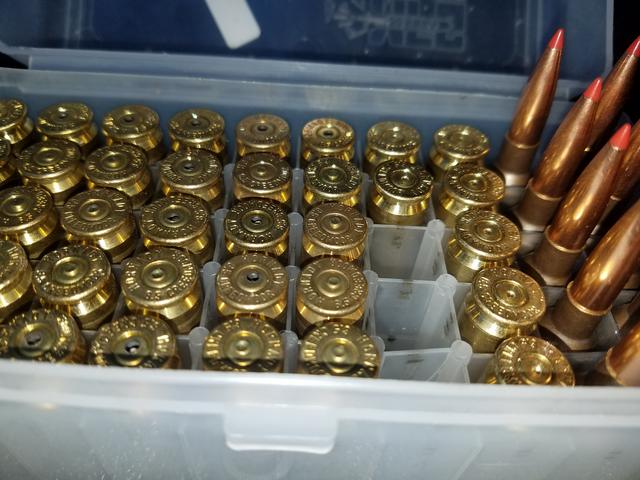I've had an ongoing problem with primers blanking. Edge of the primers were still very round, no flattening but the primer cup brass was extruding into the firing pin hole, pushing the firing pin back in.
The stock firing pin in the SPR is .079 and the hole is .084. The extrusions were .084 in diameter, but not flowing around the firing pin tip, they were pushing the firing pin back in. So, the issue wasn't the .004 clearance.
The issue was the area of the firing pin hole.
P=F/A where P is pressure, F is force and A is area. So:
If i set P to the saami chamber pressure (62,000) and A to: (.084/2)^2 (pi), then calculate for F, it get a force of 343.58lbs focused the .027 thick layer of brass over the firing pin hole.
Now, if i calculate the area of the brass in shear: (.027 x .084 x pi), i get .00712 inches^2 in shear. So, the area in shear is under 48255 psi, exceeding the shear strength of the primer cup.
The sheer strength for work hardened cartridge brass is around 45000 psi. So, the primer brass extrudes into the firing pin hole.
Now, if i turn the firing pin to .062, and bush the hole to .0635 and recalculate for a .0635 hole, i get:
62,000 = F/(.0635/2)^2(pi) i get a force of 186 lbs focused on the .027 thick brass layer above the hole. This puts the area in shear (.027x.0635xpi) at .00506"^2.
So, with the .0635" hole, the area in shear is under 36758psi.
With a .0635 firing pin hole and a .062" firing pin, the shear strength of the brass is not exceeded and does not extrude into the firing pin hole.
All values above rounded to several decimal places.
So, i turned a bushing from 4130 chromoly, machined the bolt face and with a .002 press fit, installed the bushing.
Before and after: the 7 cases in the right two columns are after the bushing install. The rest are before.
The load was the same for all, 41.6 grains of h4350, hornady brass, remington 9-1/2 LR primers, 140 amax @ 2710 fps from a benchmark 5 land chromoly 23" barrel.

I wonder why FN chose to use a .079 firing pin? It was designed for a .308, which has about the same chamber pressure.
The stock firing pin in the SPR is .079 and the hole is .084. The extrusions were .084 in diameter, but not flowing around the firing pin tip, they were pushing the firing pin back in. So, the issue wasn't the .004 clearance.
The issue was the area of the firing pin hole.
P=F/A where P is pressure, F is force and A is area. So:
If i set P to the saami chamber pressure (62,000) and A to: (.084/2)^2 (pi), then calculate for F, it get a force of 343.58lbs focused the .027 thick layer of brass over the firing pin hole.
Now, if i calculate the area of the brass in shear: (.027 x .084 x pi), i get .00712 inches^2 in shear. So, the area in shear is under 48255 psi, exceeding the shear strength of the primer cup.
The sheer strength for work hardened cartridge brass is around 45000 psi. So, the primer brass extrudes into the firing pin hole.
Now, if i turn the firing pin to .062, and bush the hole to .0635 and recalculate for a .0635 hole, i get:
62,000 = F/(.0635/2)^2(pi) i get a force of 186 lbs focused on the .027 thick brass layer above the hole. This puts the area in shear (.027x.0635xpi) at .00506"^2.
So, with the .0635" hole, the area in shear is under 36758psi.
With a .0635 firing pin hole and a .062" firing pin, the shear strength of the brass is not exceeded and does not extrude into the firing pin hole.
All values above rounded to several decimal places.
So, i turned a bushing from 4130 chromoly, machined the bolt face and with a .002 press fit, installed the bushing.
Before and after: the 7 cases in the right two columns are after the bushing install. The rest are before.
The load was the same for all, 41.6 grains of h4350, hornady brass, remington 9-1/2 LR primers, 140 amax @ 2710 fps from a benchmark 5 land chromoly 23" barrel.

I wonder why FN chose to use a .079 firing pin? It was designed for a .308, which has about the same chamber pressure.
Last edited:

